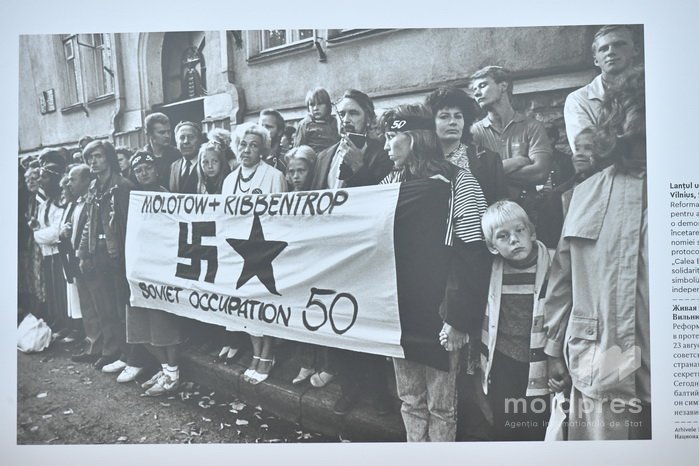
National Museum of History of Moldova hosts exhibition - Division of Europe. Consequences of Ribbentrop-Molotov Pact
The National Museum of History of Moldova hosts starting today an exhibition - Division of Europe. Consequences of the Ribbentrop-Molotov (Hitler-Stalin) Pact, organized on the occasion of the 85th anniversary of the signing of this document that marked the fate of the continent.
The exhibition is carried out in partnership with Konrad-Adenauer-Stiftung Republic of Moldova, Museum Berlin-Karlshorst, and the National Association of Young Historians of Moldova. The public is invited to explore, through archival documents, photographs, maps, and personal testimonies, the impact of the pact signed in 1939 on Poland, the Baltic countries, Romania, and other states in the region.
"The pact between two dictatorships had a detrimental impact on your country but also on Europe. It is a tragic history of terror and the occupation of your country. That is why this exhibition is important to know where we come from and where we are going, and this unites us as Europeans," declared Brigitta Triebel, director of the Konrad-Adenauer-Stiftung office in the Republic of Moldova.
Minister of Culture Sergiu Prodan emphasized the theme's relevance and the importance of reflecting on recent history.
"This exhibition is about the history of Europe and its geography. These placards speak of a division between two rulers, as they considered themselves, of the entire Europe and the entire world. If past mistakes are not condemned, they not only risk being repeated but actually mean that someone wants to repeat them. This exhibition is not about memory of the past, it is about understanding what is happening today."
The new agreed ambassador of the Federal Republic of Germany in the Republic of Moldova, Hubert Knirsch, said "it is good to organize such events because this page of history needs to be known and heard, and most importantly - not to be repeated."
The exhibition can be visited at the National Museum of History of Moldova by 6 September 2025.
PHOTO GALLERY // Romanian Blouse, proudly worn in Moldova – symbol of roots and national identity
Three opera evenings in open air at DescOperă 2025 Festival in Moldova
PHOTO GALLERY // Exhibition by Ukrainian fine artist Victor Sydorenko opened in Chișinău
Exhibition of Ukrainian fine artist inaugurated at Art Museum of Moldova
Two wineries of Moldova potential objects of UNESCO World heritage; Moldovan culture minister says country has chances to be listed till 2030
PHOTO // Moldovan parliament speaker attends brass bands festival, held in Hancesti
PHOTO // Exhibition dedicated to national poet Mihai Eminescu inaugurated at Moldovan parliament's headquarters
Approved in Parliament: Owners of historical monuments can get money from National Culture Fund
Moldova to establish territorial registers for intangible cultural heritage
USMF 'Nicolae Testemițanu' ranks second nationally in Webometrics
DOC // Citizens to pay less for electricity as of today
National Museum of History of Moldova hosts exhibition - Division of Europe. Consequences of Ribbentrop-Molotov Pact
Deputy Prime Minister, Lithuanian parliamentarians discussed reforms in Chișinău and developments on European agenda
EBRD launched tender for construction of high voltage power line Bălți–Suceava
Moldovan Central Electoral Commission's reaction to distribution of falsified video involving CEC president
DOC // Published in Official Journal; Moldovan citizens living in UK to be able to exchange driving licenses without additional exams
International painting exhibition staged in Chisinau; Colors of Peace camp brings together artists from five countries at National Library
Prospects for Moldova-Lithuania cooperation on regional security, EU enlargement discussed in Vilnius
Moldovan MPs adopt 260 acts in 160 hours at 2025 spring session
Moldovan government promises bigger awards for sportspeople medaled at international competitions
Rising rates for Euro, U.S. dollar in Moldova last day of July
Moldovan government facilitates access to Cultural Voucher Programme
Moldovan Central Electoral Commission confirms nominal composition of of electoral councils of municipal, district constituencies
Moldovan parliament speaker has discussions with high-ranking officials from Latvia, Sweden
Moldovan Central Electoral Commission receives application for registration of candidates for MP on behalf of party


